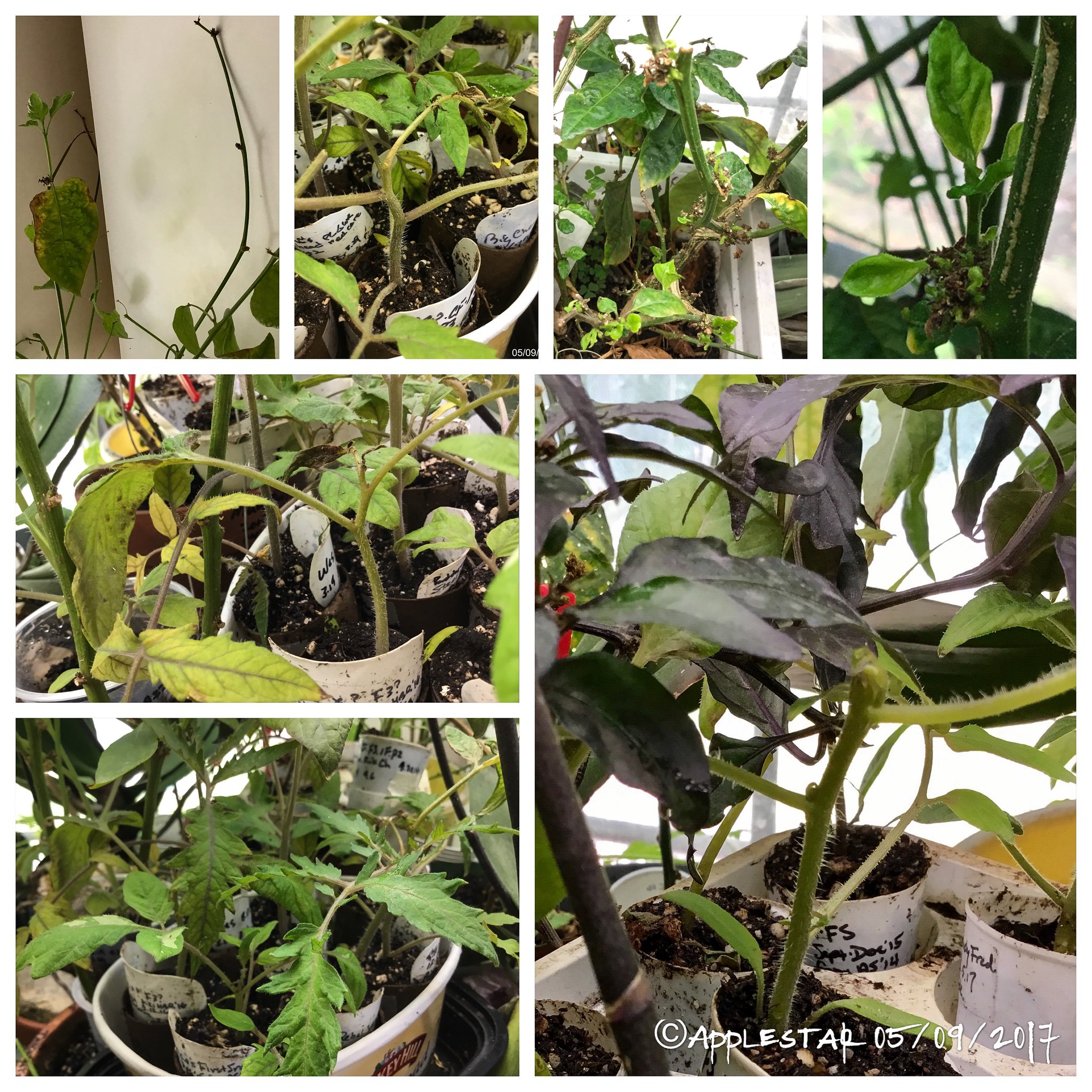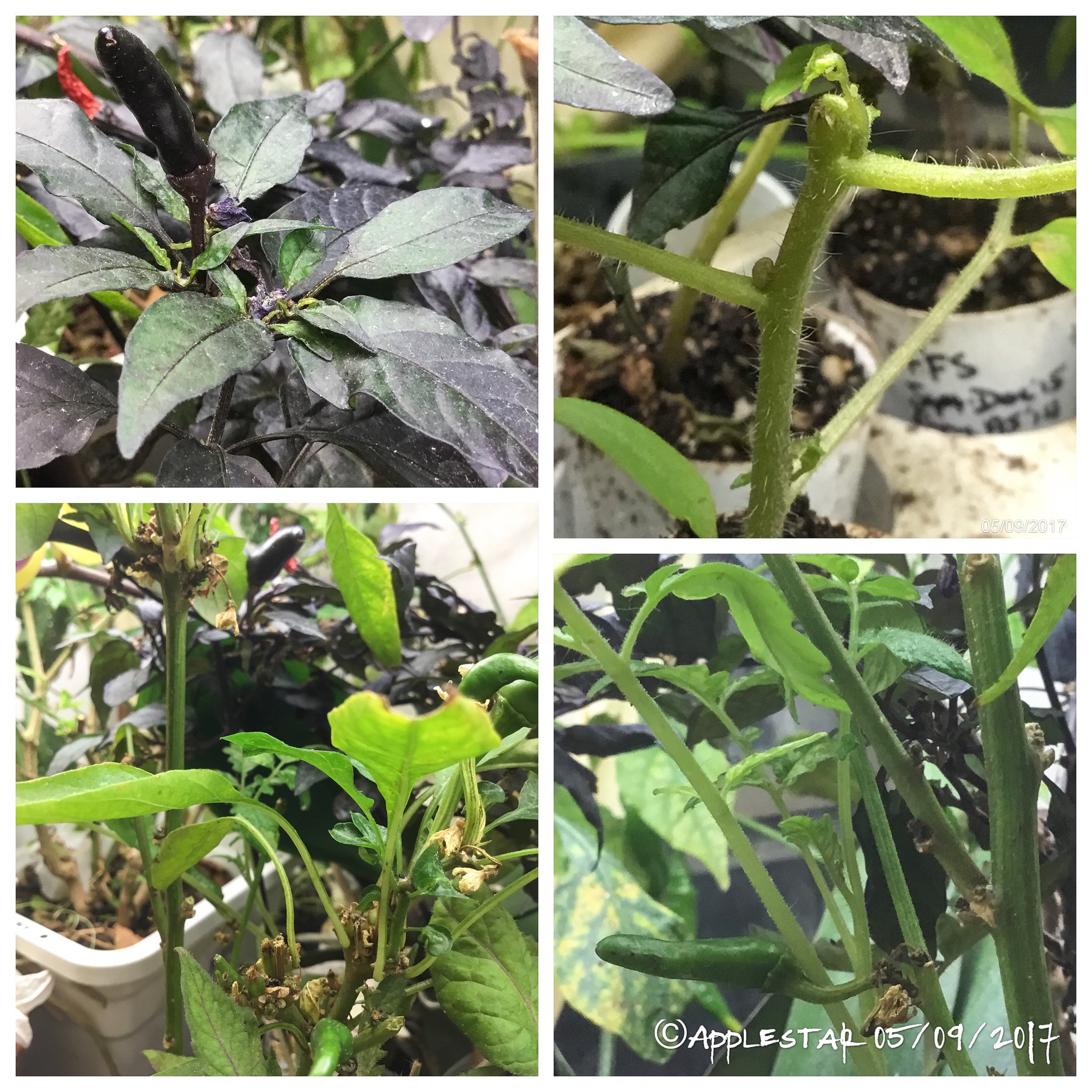- Tropicalgirl
- Full Member
- Posts: 10
- Joined: Sat Sep 22, 2018 11:33 pm
- Location: Hawaii
 Bumps on my pepper plants (nodes)
Bumps on my pepper plants (nodes)
Hi! I'm new here and also new at growing sweet peppers. I have 3 sweet pepper plants I started from seed growing in 2 large pots. They are inside my apartment. They started growing great and within 4 months one of them started to flower. The problem is that the flowers dropped and 2 of the plants started to grow weird bumps on the nodes (see the pics- sorry they are sideways). The plants have stopped growing since then and the bumps keep getting bigger. Some of the leaves also shriveled and fell. They have been like this for a few months now but I can't seem to fix the problem. I added fertilizer, I transplanted them, tried controlling the amount of water/sun etc. I checked for bugs and didn't see any. Any recommendations would be great! I can't find anything similar online. 
- applestar
- Mod
- Posts: 30540
- Joined: Thu May 01, 2008 7:21 pm
- Location: Zone 6, NJ (3/M)4/E ~ 10/M(11/B)
Uh oh. Those bumps in the growth nodes are sign of mite infestation. If you were to examine with 40-60x magnification, you would be able to see them.
They continuously suck/nip the tender buds dry, and the pepper gamely tries to grow more new buds. Eventually, all available bud growing cells are exhausted, then the leaves will continue to look good but the plant will not be able to grow.
Here is a detailed possible treatment, though with such tiny plants, I’m not sure if they can recover. Since you have your growing in a larger pot, you might consider digging them up and putting in a smaller pot or even cradling the roots in a ziplock bag of potting mix while you are treating them. OR just cover the surface of the potting mix with plastic to block new mites from emerging from the soil, and thoroughly spray on the treatment described below. (your plants are small enough that it won’t be too difficult to get full coverage). Be sure to protect the wall behind them — the Oily spray might stain.
*Note that a possible source of the mite incursion in your indoor environment is contaminated potting mix. They could also have stowed away on your clothing when you brushed up to an infested plant.
 Subject: My Marigold seems to be dying. Please help!
Subject: My Marigold seems to be dying. Please help!
...if you still have time in your season, you might want to start some more seeds and grow them in a separate location as back up. You may find that the new seedlings will overtake those earlier ones with warmer conditions, but because peppers take a long time to establish good root system, I think it might still be worth trying to restore them to health.
They continuously suck/nip the tender buds dry, and the pepper gamely tries to grow more new buds. Eventually, all available bud growing cells are exhausted, then the leaves will continue to look good but the plant will not be able to grow.
Here is a detailed possible treatment, though with such tiny plants, I’m not sure if they can recover. Since you have your growing in a larger pot, you might consider digging them up and putting in a smaller pot or even cradling the roots in a ziplock bag of potting mix while you are treating them. OR just cover the surface of the potting mix with plastic to block new mites from emerging from the soil, and thoroughly spray on the treatment described below. (your plants are small enough that it won’t be too difficult to get full coverage). Be sure to protect the wall behind them — the Oily spray might stain.
*Note that a possible source of the mite incursion in your indoor environment is contaminated potting mix. They could also have stowed away on your clothing when you brushed up to an infested plant.
...In your case, if they recover, give your plants more light — they look a bit spindly, though I can see you have been doing a good job so far. Mites are difficult pests to deal with because most cannot be seen without magnification. I have trouble with them when my plants come inside for the cold months of the year, and have resorted to buying/using predatory mites for control.applestar wrote:The tiny white spots on the leaves to the right and the webbing on the branch to the left indicate severe mite infestation. Cut off the web encased branch and dispose of it — that one is not salvageable.
First thing to do is to wrap the top of the pot with plastic (bag or wrap) so the potting mix doesn’t fall out and dunk and thoroughly swish the plant in a deep bucket of water. You will want to remove the opened flowers before starting because they will be damaged by such treatment. If you want to cut and enjoy the flowers, gently soak them wrapped in paper towels to completely submerge and treat separately, since you don’t want to spread the mites that will be on the flowers elsewhere.
Start with plain water and see how much you can get off. Then change water and use plain soap (not detergent) so the water becomes cloudy, then add a few drops of very light, refined oil like canola/rapeseed oil. Thoroughly swish the plant in this — dunking in and out and side to side, turn upright and allow to drip onto the plastic covering the pot and potting mix. Then remove the plastic and allow to drip down to the potting mix as well. Take the opportunity to thoroughly soap-clean the outside of the pot (don’t forget to clean the surface of the area where the pot was situated). DO NOT PUT THE PLANT IN DIRECT SUNLIGHT.
After 5 minutes, rinse thoroughly in clear plain water. Keep the potting mix from drying out but leave in bright light but only filtered sun, isolated in quarantine from your other plants.
Repeat every 3 days for 2 weeks.
Note that this is a drastic treatment. Your plant may or may not survive it, especially since it is very badly infested. But at the end of it, you will have tried. If you are not up to it, I’m pretty sure the advice would be to chuck the plant, especially an annual like marigold. Since you will be subjecting it to water so much, be careful that it doesn’t get OVERwatered. If secondary fungal/mold infection is a possibility (humid climate), add 1/2 teaspoon per quart of baking soda (sodium bicarbonate) or if you can get it potassium bicarbonate to the treatment water. You can also spray with 1:7 milk:water solution between treatments (this will also provide a small amount of nutrients without over feeding the sick plant).
If new buds and shoots start to grow and the plant shows signs of recovery, it will be a good idea to uppot it — the current pot is too small and is likely stressing it, making it vulnerable to infestation and disease.
...if you still have time in your season, you might want to start some more seeds and grow them in a separate location as back up. You may find that the new seedlings will overtake those earlier ones with warmer conditions, but because peppers take a long time to establish good root system, I think it might still be worth trying to restore them to health.
- applestar
- Mod
- Posts: 30540
- Joined: Thu May 01, 2008 7:21 pm
- Location: Zone 6, NJ (3/M)4/E ~ 10/M(11/B)
This is rather a long post, but I will copy it here for your reference —
Subject: Tomatoes (and peppers) plagued by mites... but recovering
Subject: Tomatoes (and peppers) plagued by mites... but recovering
applestar wrote:Tomatoes (and peppers) plagued by mites... but recovering
...(hopefully)...
I've mentioned elsewhere that I released predatory mites earlier in the winter on my overwintering peppers and other plants in an attempt to forestall repeat of last year when they were devastated by mite infestation (some TRM {tomato russet mites} as well as possibly broad mites and/or cyclamen mites). Moreover, last year, my tomato seedlings that I started later in the winter were severely infested and I had some heartbreaking losses.
The predatory mites were mostly successful. Almost all of the peppers that were initially showing signs of mite infestations have recovered to some degree. Some look really fantastic. At this point, I feel confident that once they can be put outside where the Garden Patrol regulars can have access to them, the mature peppers will be able to continue to recover and grow for the season.
Now my concern is for the new tomato seedlings. A small number have started showing signs of mite infestation and I lost about 1/2 dozen so far. I have been nestling the most recent patients among recovered pepper foliage in hopes of having some of the predatory mites that may still be present to transfer over to the seedlings.
I thought I would share photos of what the mite does to the plants first. So in the first collage, note how the mites destroyed all the growing points in the leafnodes. Peppers are so resilient that they will try to grow out dozens of buds from each node -- that's what all those blasted bumps are. When they are incapable of getting ahead of the mite infestation and every possible growing point has been blasted, the entire branch will become useless even though the tattered mature leaves might remain. Then the peppers will try grow a new node from somewhere lower down. With tomatoes, the top growing point is destroyed first, then the tomato will attempt to grow a single new bud from each leaf node. If all the above ground leafnodes fail, they will try to grow from the buried leaf nodes or possibly they are capable of generating a new bud on the stem just above the roots IF the root system is strong enough.
According to my experience last year, very young seedlings were not able to recover while older seedling were sometimes able to grow an entirely new plant even after they had been left with nothing but a single leafless stick.
The plants in the next collage are showing signs of recovery:
- Tropicalgirl
- Full Member
- Posts: 10
- Joined: Sat Sep 22, 2018 11:33 pm
- Location: Hawaii
- Tropicalgirl
- Full Member
- Posts: 10
- Joined: Sat Sep 22, 2018 11:33 pm
- Location: Hawaii
I decided to treat the pepper plants without removing them from the pot. I just transplanted them a few weeks ago so they probably wouldn't survive another uprooting. I was able to spray them with clean water, a canola oil/water mix and one last rinse with clean water. I sprayed the soil a bit with the oil mix just in case, hope that doesn't affect it. I also sprayed the tomatoes soil as well with the oil mix. Thanks for identifying the problem and providing a solution! Keeping my fingers crossed the plants survive.


